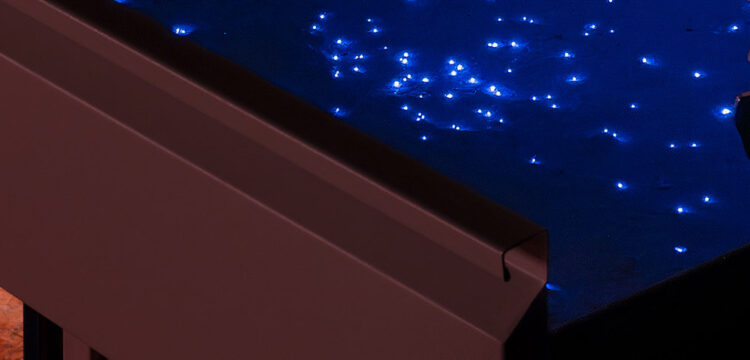Chance, Trespass
and political geography in the artwork of Stelios Kallinikou
Much like the colonial ghosts that linger on the island of Cyprus and beyond, chance is a subterranean force—operating outside of the symbolic order; refusing linearity and coherency. Chance, by way of its elusive nature, is antithetical to the masculine logics of modernity and the violent organising principles of racial capitalism. For Lacan, the chance encounter is mist; “the missed encounter” with the real. A cursory attempt to codify chance, then, is an invariably haphazard endeavour. Yet, what would it mean to mobilise one’s artistic practice alongside the contours and mysticality of chance? The myriad of possibilities awarded by chance is a reoccurring theme in Stelios Kallinikou’s work, concretising in a distinctly personal insight into the symbiotic relationship between locality, ecological destruction, tapestries of surveillance, and the manifestation of persevering colonial legacies in Cyprus.
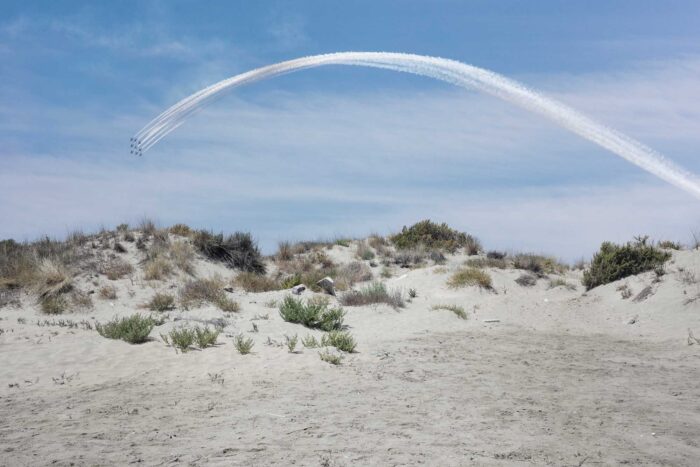
Stelios Kallinikou is a Cypriot multimedia artist who works at the intersection of site-specific installation, photography, video, and sound. His practice is deeply attuned to articulating a politics of seeing/witnessing, remembrance, and political geography by the very act of artistically depicting a series of chance encounters. Kallinikou has often likened the island to an expansive studio; a reflexive terrain. By way of example, Bird [ζευκαλάτης] (2022), featured in Kallinikou’s most recent solo exhibition Calls and Songs (2024), depicts a video loop of a bird increasingly agitated by its own reflection in the side-view mirror of a car. The video installation is, in itself, implicated with the spectral nature of chance—what are the chances Kallinikou would capture this moment; the bird would react in this repetitive motion of ecstatic territoriality and enunciation? Modernity is an all-consuming macrophage, whose debilitating concern for rigidity, enclosure, structure, and order precipitate into the severing of our connection to and experience of nature’s sublime. Equally, humanity’s ingerence into nature is altogether exemplified by this momentary happenstance; this chance encounter; the bird’s vibrant confusion by its own reflection.
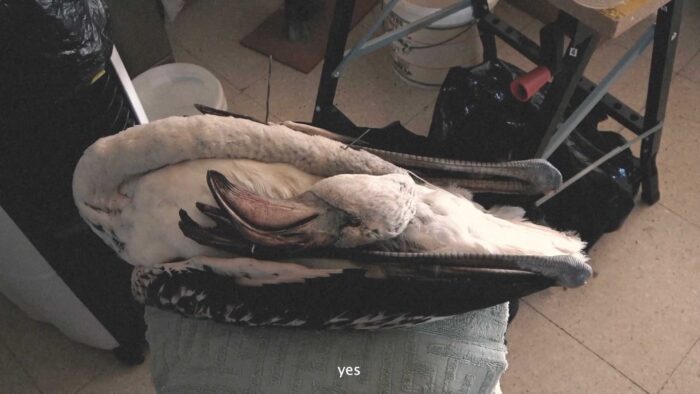
Elsewhere in Kallinikou’s work, the intimacy of chance is mediated through a series of fragmented encounters with the natural world. In the shadow of enduring “colonial remnants” that persist on Cyprus, Kallinikou’s work is attuned to the living-commotion instilled within the very fabric of nature across the island. To that end, his work is less about concocting a conscious habit of documenting and halfheartedly producing, and is instead concerned with meeting the mysticality of chance as it manifests in the context of the natural world. Consequently, this has led him to develop and refine an artistic register of political commentary. Nature gives rule, yes, but chance revives that giving with austere extravagance. In the case of Star Gaze (2019), Kallinikou’s relationship to the poetic reverberations of chance within nature is especially difficult to ignore. On a snow-ridden day, Kallinikou climbed to the peaks of Troodos—Cyprus highest mountain range—to continue his work of documenting the existence of surveillance architecture on the island. By some mysterious stroke of fortuity, his camera lens inadvertently captured the innocuous traces of his breathing. The result is illustrious; a mystical echo of chance; a subtle reminder that human interference is a double-edged sword.
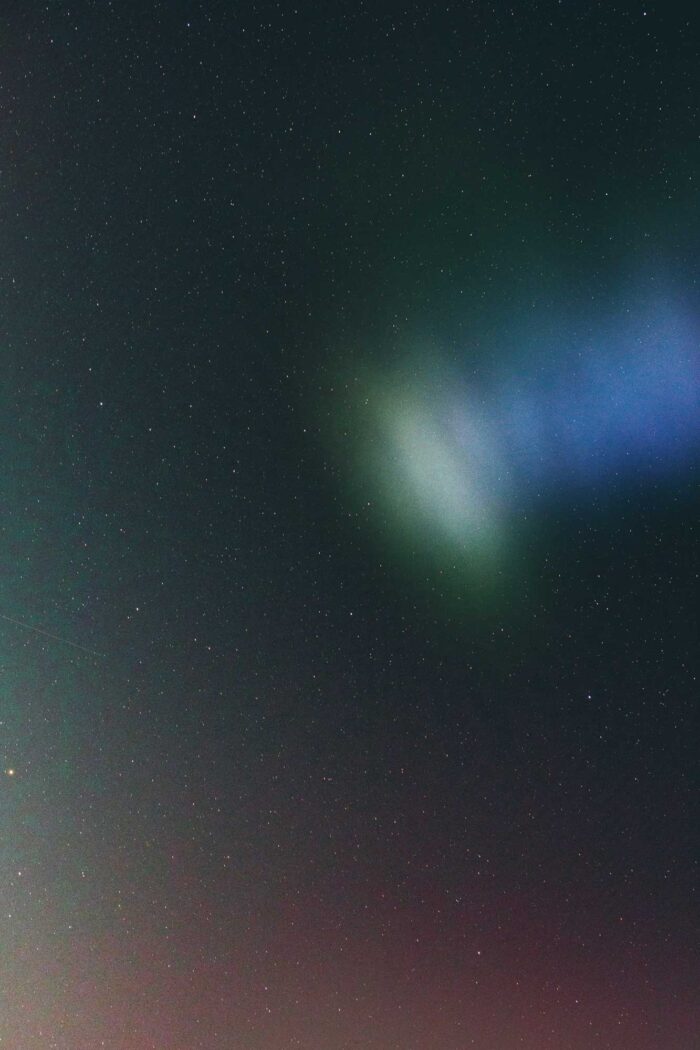
Likewise, Radar Station (2018) is part of Kallinikou’s expansive photographic work aimed at delineating the enduring existence of Britain’s overseas military apparatus on the island. The eerie night photograph documents the dual-existence of the RAF Troodos Station and the Starbook system/telescope of the National Space Centre. The former is the oldest military outpost on the island, dating back to 1878 with a tenacious “capability to monitor civil and military air traffic over and around Cyprus, Syria, Lebanon, Palestine, and parts of Egypt and Turkey.” The latter is able to scan the skies for objects as small as one meter in length, and satellites orbiting in space. Through this singular work, Kallinikou acutely confronts Britain’s perennial colonial regime. While he attempts to document the quiet wonders of nature, and the celestial, the presence of such a surveillance/satellite system illustrates the attendant violence that endures in the deep naturescapes of Cyprus. Here, and in the case of Star Gaze, Kallinikou’s pictorial interventions attend to the “critical question about how our sky has been globally controlled, monitored, and scanned.”
In a similar vein, Kallinikou’s practice is bound together by a strong desire to articulate an intimacy that emerges not from the absence of violence, but in spite of its pervasive abundance. This is a wayward approach, tied closely to the artist’s vibrant trust in the rhythms of the Earth to elucidate meaning in the midst of ongoing and manufactured geopolitical turmoil. Reflexively, Kallinikou turns to his own island in the Mediterranean to wrestle with the struggle towards an “incomplete project of freedom.” While Cyprus is a relatively young nation state, only attaining independence in 1960, Britain retains sovereignty of three percent of the island in the form of military bases and outposts. Deeply ingrained colonial remnants, such as the “restricted” zones of the Sovereign (military) Base Areas of Akrotiri and Dhekelia, are points of significant attention in Kallinikou’s work. As a natural by-product, then, the troubled sociological and theoretical term of “post” coloniality makes frequent appearance throughout his work.
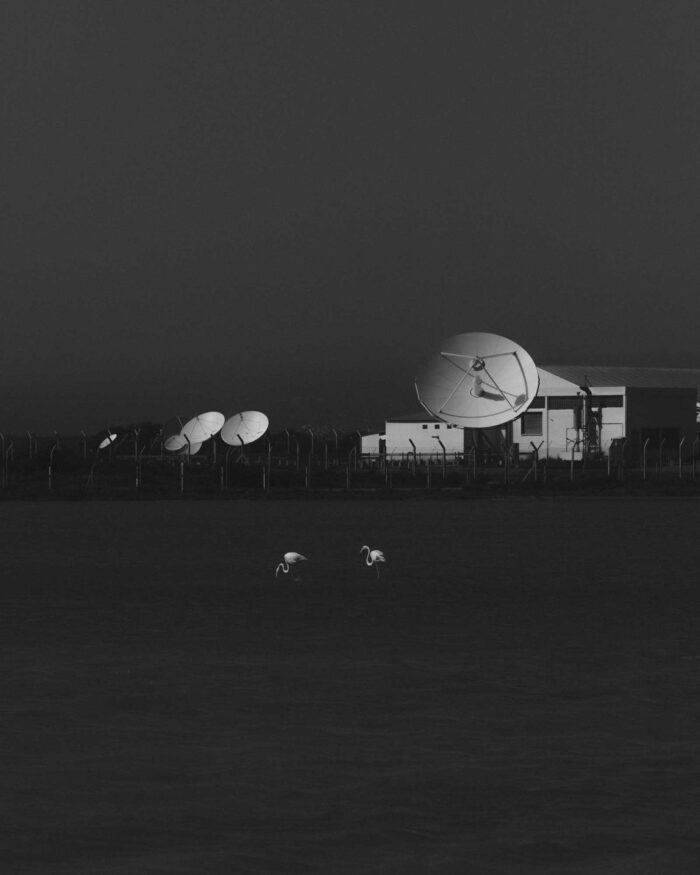
In the case of Flamingo Theatre (2015–ongoing), Kallinikou juxtaposes the grandeur of nature with the latent violence of surveillance, covert warfare, and militarisation emanating from RAF (Royal Air Force) Akrotiri in Limassol, Cyprus. As a body of work, this photographic series captures the migratory patterns of the flamingos in Akrotiri, pitting them in stark contrast to the routine take–off of RAF fighter jets which have been mobilised in the 2014 missile strikes against Yemen and the 2018 missile strikes against Syria. As Peter Eramian writes, “the flamingos animated in RAF symbols and model airplanes mimic military operations; the local and global overlap, identities break down and ecology meets history.” It is at this precise (non)site of contestation that Kallinikou stages a metaphorical “theatre,” giving way to an ongoing analysis surrounding the abstract, yet violent relationship between the militarised operations of RAF Akrotiri, the Akrotiri Salt Lake as a vital stop-over for migratory flamingos, and the lingering colonial tensions between empire and locality. Through this series of photographs, Kallinikou explores the multilayered connection between the destruction of ecology and biodiversity and its vapid relationship to the hegemony of the West, gross militarisation, and legally codified land theft.
In the short documentary film Bird Watching (2023), which appears almost a decade after Flamingo Theatre, Kallinikou returns to the flamingos of Akrotiri. As a native of Limassol, Kallinikou’s interest in Akrotiri has a personal register; is altogether a stark reminder that the personal is political. Instigated by Cyprus” long-term transfiguration into a launchpad for covert activities carried out by the West, and amid reports of routine reconnaissance missions carried out by RAF Akrotiri over Gaza, Kallinikou draws out the deep seated relationship between militarisation, the physical borderisation of the island’s natural commons, and the ongoing intertwined violence of global settler colonialism. As Marina Ashioti and Irini Khenkin assert in a publication produced for the Cypriot Pavilion at the 2024 Venice Biennale, “the Island of Venus (Cyprus) is the Island of Spies.” Put otherwise, given Cyprus’ geographical location in the Mediterranean Sea and its deep mythological allure, the island itself has congealed into a clandestine and proxy launchpad for Western imperialist aims.
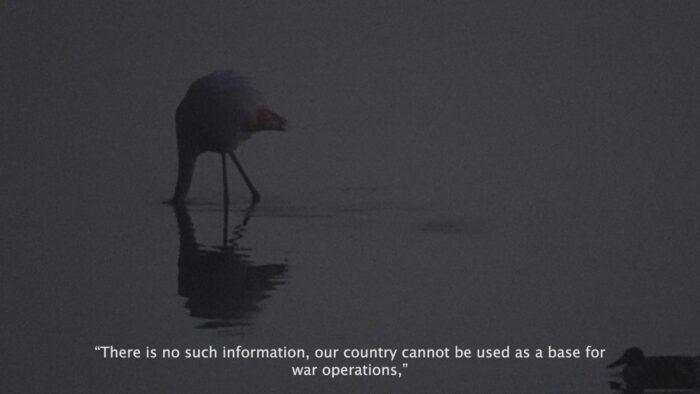
Equally, RAF Akrotiri houses “a huge curtain antenna, code-named PLUTO, with the ability to detect airplanes and missiles in countries as far as Afghanistan, Kazakhstan, and parts of the Russian Federation.” In Bird Watching, Kallinikou documents his conversations with locals in the area of Akrotiri, voicing their concerns regarding the horrific deaths and steady decline of the flamingos that congregate at the Akrotiri Salt Lake. While RAF Akroti denies that the extensive surveillance apparatus has an immediate effect on local ecologies, locals are increasingly suspicious and less inclined to believe the militarised mouth-piece of a colonial regime that continues to cede three percent of the island to British control. After all, “RAF Akrotiri is the biggest British air base outside the UK.” Throughout the film, images of flamingos are juxtaposed with the global media establishment’s reporting on how the base is actively being used by the British Armed Forces. The film ends with a scene with a local discussing a dead flamingo found under the British curtain radar antennas. By documenting the dead flamingos found by locals, Kallinikou depicts the ongoing pollution and fumigation of the marshlands—a direct result of RAF Akrotiri’s routine reconnaissance missions, including its abetting of a genocide taking place 403 kilometres away from the island’s shores—as having had a disastrous effect on the natural ecosystems, and life itself. Anti-chance rears its head here; the presence of the Sovereign Bases in Cyprus is not by chance. Codified by virtue of the island’s constitution, the coloniality of Cyprus prolongs itself, ultimately stifling any attempt by the land to heal, or simply exist. As Kallinikou urges us to examine through the instance of this short film: “the world is on fire,” “pristine nature doesn’t exist anymore,” militiarisation is closely tied to the corralling of our shared commons, and the exacerbation of violence towards Cyprus’ Levantine neighbour increases by the day.
In the dual instance of Flamingo Theatre and Bird Watching, Kallinikou extrapolates the intimacy inherent to wandering and meeting chance in the open field. By this virtue alone, the artist formulates a distinctly personal form and pitch of local poetry. Through a deeply haunting collection of photographs and videos captured by Kallinikou during his own peripatetic excursions in RAF Akrotiri, we are swiftly embroiled in the artist’s encounter with a “past that is not past.” Throughout these works, Kallinikou offers insurgent reflections on the violent choreography of surveillance, the persevering brutality of colonialism, and the manifest effect of this matrix on the ecological landscape of Cyprus. Similarly, this series of works is not simply an attempt to document the transfiguration of the land into a militarised outpost, but to allude to nature’s existence in spite of persevering colonialist and imperialist agendas; linear time.
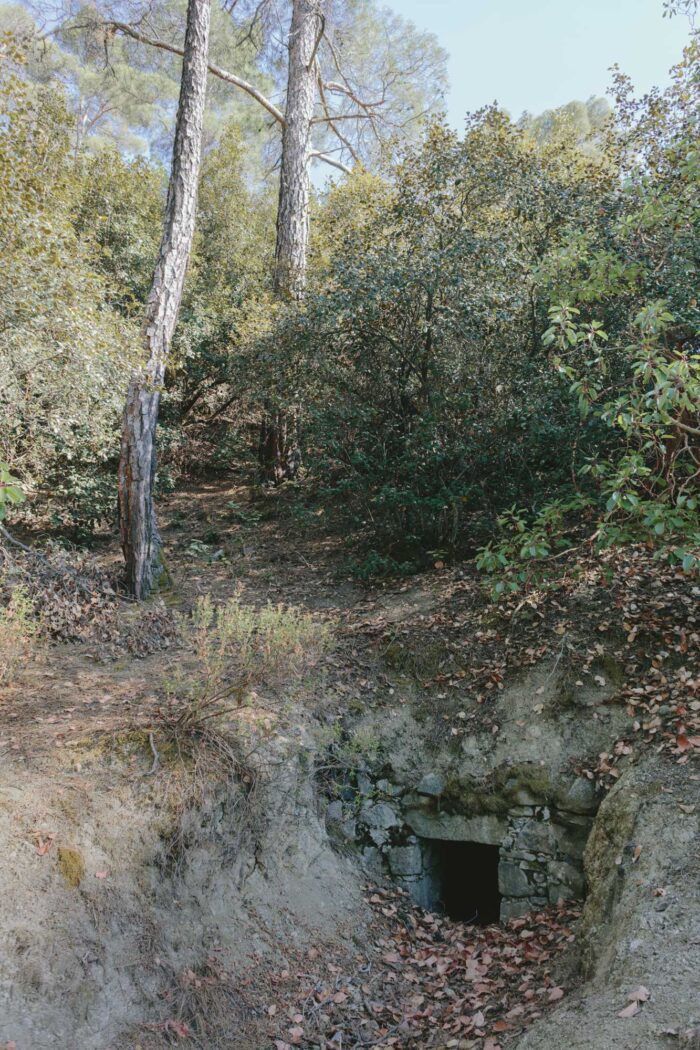
On a similar note, Kallinikou’s work equally harbours a heartfelt intent to think of Cyprus as an island haunted by an ever-present ghost in the crackle. Much like the long-delayed echo of the ghosts that linger, the past is not “simply preserved but persists as a spectral presence that informs and deforms our present.” Kallinikou’s openness to visually embody the traces and spectral murmurs often overlooked or obfuscated is illustrated in his exhibition Where are you going young man, handsome like a legend (2017). Kallinikou’s adamant refusal to coalesce, subscribe, or romanticize nationalistic attitudes emerges through the instance of this photographic series. The photographs depict bunkers and caves, shrouded hideouts that were used throughout the 1950’s during a period of armed struggle between EOKA (National Organisation of Cypriot Fighters)—a Greek-speaking nationalist organisation who championed for union (Enosis) with Greece—and British colonial forces.
A tension arises at first glance; a spectator frantically searches the scene of the photograph for threads to a larger story. And yet, this story is altogether enmeshed by the opacity of the images themselves. While many of these hideouts are regarded as national monuments by Greek-speaking Cypriots, Kallinikou’s almost-mystical approach is concerned with speculating the haphazard relationship between the island’s natural landscapes and abiding political questions, such as national belonging, identity, and place-making. This iteration of Kallinikou’s work is deeply tied to his belief that the intimate is not entirely private. The systems that govern us codify “wandering [as] trespassing.” And yet, Kallinikou “never seeks permission to access and photograph these areas.” By that metric, Kallinikou employs chance, wanderlust, and gallivanting in order to critique the very legacies that demarcate access to and routinely commodify our shared commons. To wander is itself a deliberate choice, but Kallinikou’s seemingly-fated encounter with the subjects/objects present throughout his explorations is altogether a mystery of its own.
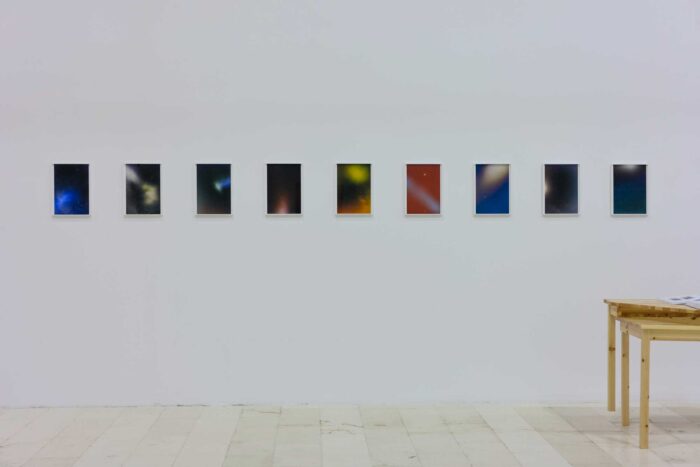
“Hapticality”—as Fred Moten and Stefano Harney remind—is the feeling that “what is to come is [already] here.” It is the growing capacity to “feel through others, for others to feel through you, for you to feel them feeling you.” The embodied sensibility awarded by way of hapticality is altogether bound up with collective recognition that the Earth is in peril. The insistently wayward register of chance, alongside an exposure to hapticality, persists throughout Stelios Kallinikou’s recalcitrant archive of work. While the artist has not made formal use of the word chance to characterize his practice, it is increasingly apparent that his attention to the melodies and rhythms of nature nevertheless attune him to the poetics and politics of chance. Through a deep invocation of Cyprus” political past–present and future, and through a distinctly attentive approach to photography and the moving-image, Kallinikou invites critical attention to the social arrangements dictated by the systems that govern us; critique of the ossifying logics, aesthetics and language of settler-colonialism. Inhabiting an artistic-political critique enshrined in a sense of mysticism and reverence to landscape, Kallinikou elucidates the relationship between coloniality, ecological crisis, and militarization as it manifests on the island of Cyprus. Kallinikou’s work is a timely reminder: “we must see the earth before the end of the world.” This is, and always has been, an emergency.



